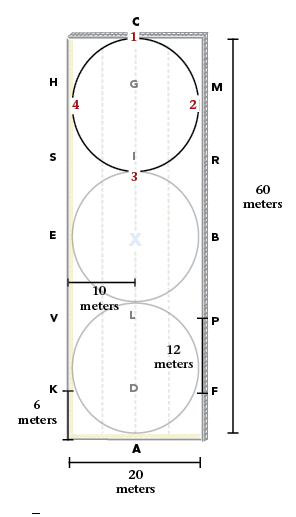With so few competitions available, I was really happy that my student and friend, Tommy, with his Off-the-Track Thoroughbred, Waldo, were able to squeak into a local dressage schooling show after being on the waiting list.
As an Amazon Associate, Dressage Today may earn an affiliate commission when you buy through links on our site. Products links are selected by Dressage Today editors.
One of the things we have focused on as we put parts of his Training Level and First Level tests together is the transition from medium walk to free walk on a long rein and back to the medium walk. Like everything else in dressage there is a “pilot’s list” of prerequisites before one can undertake a movement that would seem to be very easy but actually requires careful attention to the Training Scale in order to get that big, fat, double coefficient score!
Tommy is progressing from developing a following seat to a truly independent seat, which now opens the door for an effective seat. For example, with an effective seat, a rider can weight one seat bone for just a stride if need be, or “lead” a horse’s trot and, in Tommy’s case, really influence Waldo’s nice, stretchy walk to have him loose and supple and in front of his leg so that when he comes back to a medium walk, it really is a dynamic transition with Waldo beautifully filling out the rein.
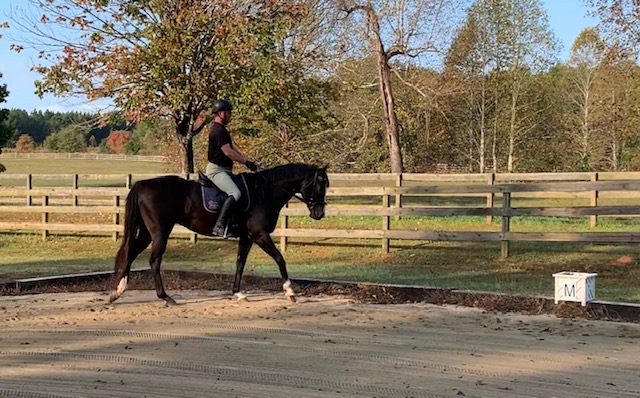
This is part of my KWPN youngster Lucas’ routine as well and I find by making these transitions a normal part of his training during our 15-minute warm-up, Lucas releases his back with ease. He first walks 10 minutes on the buckle, and then as I pick up the contact we simply change rein after each short side for another 5 minutes. It should be said that I’m quite careful with Lucas’ work at the walk and ask for very little collection as you can really screw up a young horse’s walk by asking them to come back toward collection too early and too often. You can find yourself trapped in Lateral City.
Good transitions from medium walk to free walk back to medium walk depend very much on the quality of the original medium walk and the straightness—the alignment of the shoulders as we come through the corner. If I let Lucas fall out or fall in, he will be out of balance before we even begin. So, as I feel my horse marching along in a relaxed and forward manner in his medium walk, I give a half-halt as we come through the corner and check his straightness so that I can turn him off the outside aids with ease and in balance.
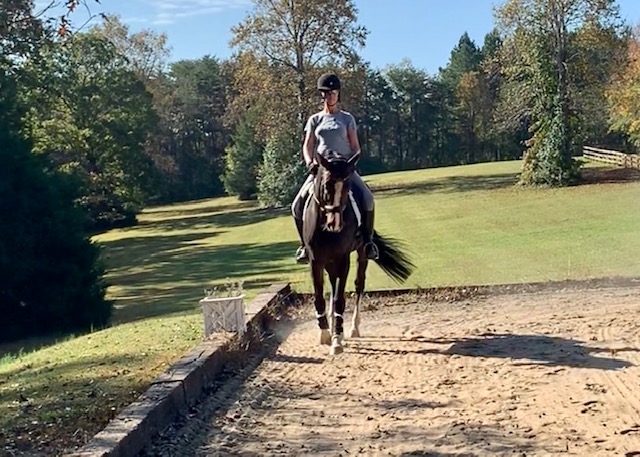
Lucas was a quick study when I taught him jaw flexions both in-hand and under saddle, therefore, he knows that as soon as I push my hands forward, maintaining a soft and steady contact, that means he is to follow my hands and stretch toward them. And, of course, for him to be able to do this, his back must be soft and relaxed. If I’ve achieved a good, balanced corner, it certainly should be.
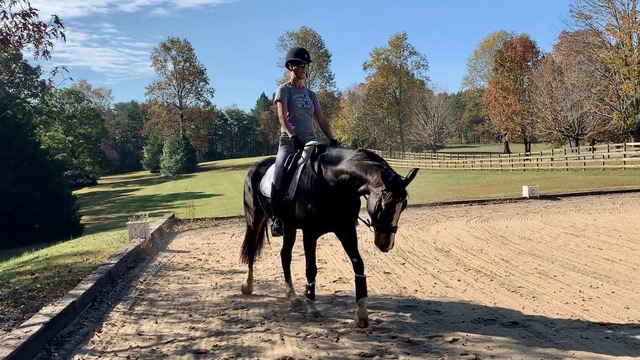
I maintain a light contact as he continues to stride forward because I don’t want to abandon our communication by letting the reins fall loose—I’m going to need to maintain an easy feel all the way across the arena to be able to request he keep reaching down and stretching, increasing his over-step.
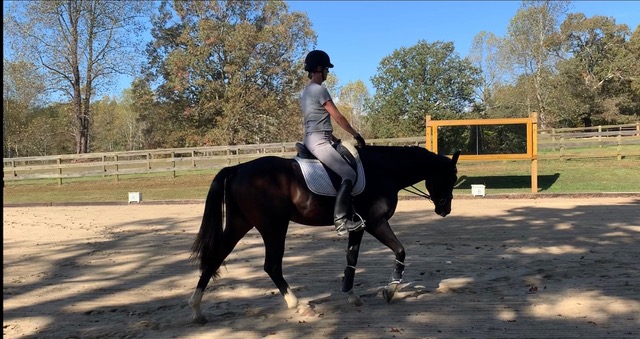
When we’re about 25 feet from our final destination, in this case, F, I keep in mind that I’m going to be asking Lucas to prepare for a new bend and yield his right ribcage and shoulder over into my left rein—which is more difficult for him than the other way—and so I begin “massaging” his ribcage with my inside calf as I step deeply into my right heel and slightly weight my inside, right seat bone. As we come very near the letter I “ooze” my weight down into both heels and think of pulling up my upper body to sit as tall as possible—this not only keeps me well balanced to assist my horse’s balance, but also helps to “still” my seat.
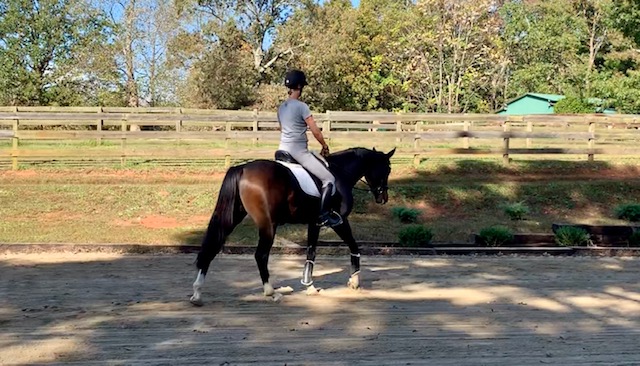
And when we arrive at F, our transition back to medium walk is seamless, on my seat and completely without tension, Lucas remaining very soft in the contact and obliging to my leg as I begin to create the bend for the corner.
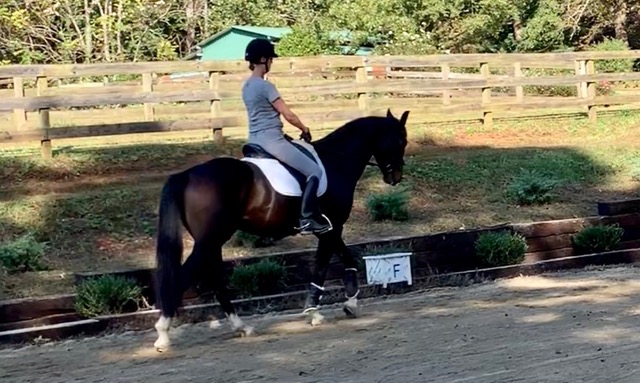
I don’t just do this exercise on the diagonal—I do it all over the place, feeding Lucas the reins as we turn onto a serpentine and asking him to remain forward and stretching as we cross centerline into a new flexion and direction, then picking him back up. I practice it down long sides … And it goes without saying that if you’re going to practice it on the diagonal as for a test and you find your horse’s back begins to grow tense as you approach the corner, “Danger, danger, Will Robinson, abandon ship!” Forget trying to transition him back to medium because you won’t be successful.
Something I always try to remember and teach my students is that each time we ride a horse, we train that horse. If we ride tension-filled transitions, then that’s what we’re training our horse to do. Whatever the reason—maybe he spotted a squirrel and dropped his back, inverted, and stiffened his jaw—just keep him walking and stretching forward until he begins to relax and follow with your forward-thinking hand before trying to throttle back again when it feels right. Maybe he’s anticipating a transition back that’s been a little hand-heavy and he’s becoming a bit defensive. You’ve got time—you don’t have to nail it perfectly each ride. Just try to achieve parts of it, as well as what the masters told us: Ride your horse calm, forward and straight. If you can achieve that, you’ll find that the transitions almost happen by themselves.
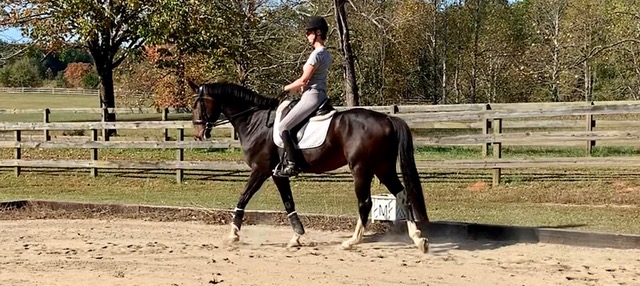
And then when you’re riding this diagonal in front of a judge, you can rest assured you and your horse are so smugly confirmed in this that you are practically guaranteed a boffo, double coefficient score! Unless some doorknob opens an umbrella on the rail …








